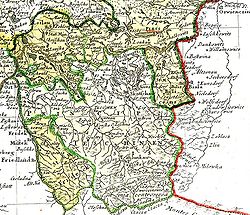Duchy of Teschen
Duchy of Teschen | |||||||||||
|---|---|---|---|---|---|---|---|---|---|---|---|
| 1281–1918 | |||||||||||
Coat of arms¹
| |||||||||||
| Status | State of the Holy Roman Empire Fiefdom of the Kingdom of Bohemia | ||||||||||
| Capital | Teschen | ||||||||||
| Common languages | Latin (officially) German (later) Polish (popularly) Czech | ||||||||||
| Religion | Protestantism, Roman Catholicism | ||||||||||
| Government | Principality | ||||||||||
| History | |||||||||||
| 1281 1281 | |||||||||||
• Bohemian rule | 1327 | ||||||||||
• Habsburg rule | 1653 | ||||||||||
| 28 July, 1920 1918 | |||||||||||
| Population | |||||||||||
• 1910 | 434,000 | ||||||||||
| |||||||||||
¹ Coat of arms of the Duchy of Teschen and the regional branch of the Piast dynasty | |||||||||||
The Duchy of Teschen or Duchy of Cieszyn or Duchy of Těšín (Czech: Těšínské knížectví; German: Herzogtum Teschen; Latin: Ducatus Tessinensis; Polish: Księstwo Cieszyńskie), was an independent duchy centered on Teschen (Cieszyn) in Upper Silesia, one of Duchies of Silesia.
History
The duchy shared the history of Cieszyn Silesia, and also in part Silesia in general; after the feudal division of Poland it was split off in 1281 and ruled by Silesian dukes from the Piast dynasty since 1290.[1] The Duchy of Teschen was also composed of smaller Duchies at various points of time, such as Duchy of Oświęcim or Duchy of Zator. The Duchy of Oświęcim was split from Duchy of Teschen around 1315 (The Duchy of Zator in turn split from the Duchy of Oświęcim in 1454).
In 1327 Casimir I, Duke of Teschen, swore a homage to the Bohemian king John of Luxembourg. Since then, Duchy became an autonomic fiefdom of the Bohemian crown.[2] Local Piast rulers often possessed other lands outside the Duchy of Teschen itself, in some periods of time. They for example owned Siewierz, half of Głogów and some land around Bytom. After the death of Boleslaus I in 1431, the rule over the duchy was shared by his wife Eufemia and their four sons.[3] In 1442 the duchy was divided between sons who were all formally Dukes of Teschen but the real control over the duchy gained Boleslaus II and Przemyslaus II who after the death of Boleslaus II in 1452 ruled alone. During the reign of Wenceslaus III Adam the duchy shifted to Protestantism according to the cuius regio, eius religio rule. However next duke, Adam Wenceslaus shifted back to Roman Catholicism. The Piast's rule continued to 1653 to death of the last Piast descendant, Elizabeth Lucretia, Duchess of Teschen.
From 1653 it was ruled by the Habsburg dynasty. In the early 18th century, it was given to Leopold, Duke of Lorraine, as compensation for his maternal grandmother's rights to the north-Italian Duchy of Montferrat, which the emperor had taken and given to the Dukes of Savoy as part of their pacts of alliance. Emperor Francis I later granted it to his eldest surviving daughter, Maria Christina, who married Prince Albert of Saxony, who thus became known colloquially as the Duke of Saxe-Teschen. Although most of Silesia passed to the Kingdom of Prussia in 1742 during the First Silesian War, Teschen remained under Austrian control as part of Austrian Silesia. Albert and Maria Christina's marriage remained childless, and upon the death of the widowed Albert, Duchy passed to their adopted son, Archduke Charles of Austria, who became Duke of Teschen and started the Habsburg-Lorraine branch of Dukes of Teschen. It passed down his line and was inherited by his eldest son, Albert Frederick. At his death in 1895, it passed into the hands of his nephew, the Archduke Frederick Maria.
The Duchy of Teschen became part of the Austrian Empire in 1804 and Austria-Hungary in 1867. At the end of World War I, local Polish and Czech self-governments were established and the duchy was divided between Poland and Czechoslovakia by the decision of Spa Conference in July 1920.
Demographics
According to the Austro-Hungarian census taken in 1910, the duchy had 434,000 inhabitants, among them 234,000 (53.9%) Polish-speaking, 116,000 (26.7%) Czech-speaking, 77,000 (17.7%) German-speaking, and 7,000 (1.6%) others.
Dukes of Teschen
Dukes of Silesia dynasty (since 17th, 18th century referred to as Silesian Piasts)

1600s Map with Teschen in Silesia/Germania
Dukes of Teschen
- 1290–1315 Mieszko I
- 1315–1358 Casimir I
- 1358–1410 Przemyslaus I Noszak
- 1410–1431 Boleslaus I
- 1431–1442 Euphemia and her sons: Wenceslaus I, Boleslaus II, Władysław, and Przemyslaus II
- 1442–1452 Przemyslaus II and Boleslaus II
- 1452-1477 Przemyslaus II
- 1477–1528 Casimir II
- 1528–1579 Wenceslaus III Adam
- 1579–1617 Adam Wenceslaus
- 1617–1625 Frederick William
- 1625–1653 Elizabeth Lucretia
Habsburg dynasty

- 1653-1654 King Ferdinand IV of Hungary
- 1654-1657 Holy Roman Emperor Ferdinand III
- 1657-1705 Holy Roman Emperor Leopold I
- 1705-1711 Holy Roman Emperor Joseph I
- 1711-1722 Holy Roman Emperor Charles VI
- 1722-1729 Leopold, Duke of Lorraine
- 1729-1765 Holy Roman Emperor Francis I
- 1765-1766 Holy Roman Emperor Joseph II
- 1766-1822 Archduchess Maria Christina and Prince Albert of Saxony
- 1822-1847 Archduke Charles
- 1847-1895 Archduke Albert
- 1895-1918 Archduke Frederick
Footnotes
References
- Biermann, Gottlieb (1894). Geschichte des Herzogthums Teschen (in German) (2nd edition ed.). Teschen: Verlag und Hofbuchhandlung Karl Prochaska. OCLC 34926439.
{{cite book}}:|edition=has extra text (help); Cite has empty unknown parameter:|coauthors=(help)
- Panic, Idzi (2002). Poczet Piastów i Piastówien cieszyńskich (in Polish). Cieszyn: Urząd Miejski. ISBN 83-917095-4-X. OCLC 55650394.
{{cite book}}: Cite has empty unknown parameter:|coauthors=(help)


